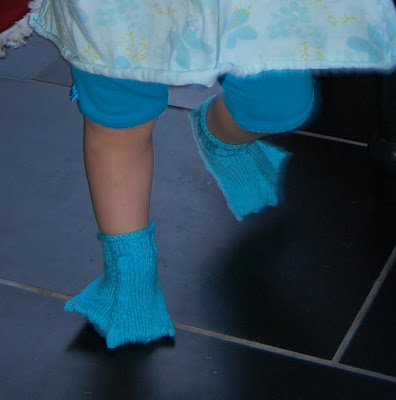
This post outlines the pattern for the toddler version of "Duck," published recently in Knitty.
I chose to model these socks after the blue-footed booby, since my husband loves the Galapagos and is a huge fan of this bird. You may of course choose your own inspiration when choosing your color. When my daughter outgrows these, maybe I'll make her some pink flamingo feet.
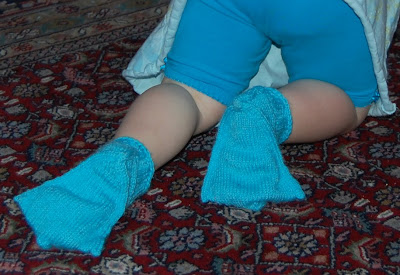
I also wanted to mention, just in case you are concerned about one possible disadvantage of hand-knitted socks for new walkers...
Fortunately for me, knitters are some of the cleverest and most creative people I know, and the fine folks at the Fiber Gallery on Phinney Ridge suggested I use fabric paint to add a little traction to the bottom. Thank you Fiber Gallery!
As always, I encourage you to thumb your nose at my instructions and play around with your own ideas.
The Gist
The booby sock pattern is very similar to the duck sock pattern. Stitch count and directions are the same, with the following exceptions:
- Use a slightly thicker yarn, and larger needles.
- Do not purl the center stitch on the bottom of the sock -- knit all the way across.
- End the center toe at the tip, where you cast on, rather than wrapping around and working to the back of the heel.
- Since you are not working the center toe along the bottom, you will end up with 6 live I-cord sts, rather than 9, to be slipped onto a 3rd needle and then onto the same holder as the heel sts.
The Details
I recommend that you reference the Knitty article Duck while making these socks, as it contains photos and illustrations of the process. The booby socks are so similar in structure to the duck socks, once you understand the gist of how they are different, you probably won't even need the instructions below. Differences between this pattern and Duck are indicated by bold red type.
MATERIALS
Yarn
Baby Ull by Dale of Norway [100% superwash wool; 175m per 50g skein]; color: #6714 Blue; 1 skein
Needles
Two US #3/3.25mm circular needles, 24 inches or longer, or one needle of sufficient length for Magic Loop. (Note: this pattern was developed for circulars, but if you are devoted to your dpn's, may I suggest you check out this video tutorial, kindly posted by Mojen.)
One set US #3/3.25mm double-point needles (you’ll need only two or three of them)
Notions
Crochet hook, close in size to US #3/3.25mm
Small stitch holders
Tapestry needle
Elastic thread (optional, but a good thing if your toddler likes to pull her socks off)
GAUGE
28 sts/40 rows = 4" in stockinette st
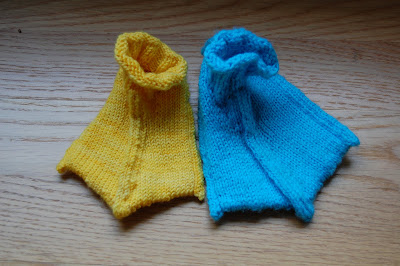
PATTERN NOTES
Please see Knitty.com for references to standard abbreviations.
This pattern also uses:
Non-standard abbreviations (these techniques are known by a couple of different names)
- RLI (Right Lifted Increase): Use the right needle to pick up the stitch below the next stitch on the left needle. Place it on the left needle, then knit into it. 1 stitch has been increased.
- LLI (Left Lifted Increase): Use the left needle to pick up the stitch 2 rows below the last stitch on the right needle. Knit into this stitch. 1 stitch has been increased.
- S2KP: Slip next 2 sts together, knitwise, as if to work a k2tog. Knit next st, then pass both slipped sts together over st just knit. This forms a centered double decrease.
DIRECTIONS
Note that a semicolon ";" indicates the halfway mark, where you change to your second circular needle. Differences between this pattern and the original are indicated by bold red type.
Shape Center Point
Using Judy's Magic Cast On, CO 4 sts (2 sts on each needle).
Round 1: [K1, yo, k1] on each needle. 6 sts.
Round 2: CO 2 sts (1 st on each needle), k2 (first st to be knit is new CO st), p1, k1; CO 2 sts (1 st on each needle), k5. 10 sts.
Round 3: CO 2 sts (1 st on each needle), k3, p1, k2; CO 2 sts (1 st on each needle), k7. 14 sts.
Shape Webbing
Round 4: CO 4 sts (2 sts on each needle), k5, p1, k3; CO 4 sts (2 sts on each needle), k11. 22 sts. Round 5: CO 8 sts (4 sts on each needle), k9, p1, k5; CO 8 sts (4 sts on each needle), k19. 38 sts. Round 6: CO 12 sts (6 sts on each needle, k15, p1, k9; CO 12 sts (6 sts on each needle, k31. 62 sts.
Round 7: K15, p1, k15; k31.
Begin Side Toes
Round 8: YO, k15, p1, k15; YO, k31. 64 sts.
Rounds 9-11: [P1, k15] twice; p1, k31.
Shape Foot
Round 12: P1, k13, k2tog, p1, ssk, k13; P1, k13, k2tog, k1, ssk, k13. 60 sts.
Rounds 13-15: [P1, k14] twice; p1, k29.
Round 16: P1, k12, k2tog, p1, ssk, k12; P1, k12, k2tog, k1, ssk, k12. 56 sts.
Rounds 17-19: [P1, k13] twice; p1, k27.
Round 20: P1, k11, k2tog, p1, ssk, k11; P1, k11, k2tog, k1, ssk, k11. 52 sts.
Rounds 21-23: [P1, k12] twice; p1, k25.
Round 24: P1, k10, k2tog, p1, ssk, k10; P1, k10, k2tog, k1, ssk, k10;. 48 sts.
Rounds 25-27: [P1, k11] twice; p1, k23.
Round 28: P1, k9, k2tog, p1, ssk, k9; P1, k9, k2tog, k1, ssk, k9. 44 sts.
Rounds 29-30: [P1, k10] twice; p1, k21.
Gusset
Round 1: P1, k8, LLI, k2, p1, k2, RLI, k8; p1, k8, k2tog, k1, ssk, k8. 44 sts: 24 sts on first needle, 20 sts on second needle.
Rounds 2-3: [P1, k11] twice; p1, k19.
Round 4: P1, k8, LLI, k3, p1, k3, RLI, k8; p1, k7, k2tog, k1, ssk, k7. 44 sts: 26 sts on first needle, 18 sts on second needle.
Round 5-6: [P1, k12] twice; p1, k17.
Round 7: P1, k8, LLI, k4, p1, k4, RLI, k8; p1, k6, k2tog, k1, ssk, k6. 44 sts: 28 sts on first needle, 16 sts on second needle.
Rounds 8-9: [P1, k13] twice; p1, k15.
Round 10: P1, k8, LLI, k11, RLI, k8; p1, k5, k2tog, k1, ssk, k5. 44 sts: 30 sts on first needle, 14 sts on second needle. Note that center st on first needle is knit, instead of purled.
Heel
Work first 9 sts of first needle in pattern; place next 13 sts on st holder for instep. Turn work so that WS is facing. Heel flap will now be worked back and forth in rows over remaining 31 sts. When working first row, work all sts onto one needle.
Row 1 [WS]: P8, k1, p13, k1, p8.
Row 2 [RS]: K8, p1, k4, k2tog, k1, ssk, k4, p1, k8. 29 sts.
Row 3 [WS]: P8, k1, p11, k1, p8.
Row 4 [RS]: K8, p1, k3, k2tog, k1, ssk, k3, p1, k8. 27 sts.
Row 5 [WS]: P8, k1, p9, k1, p8.
Row 6 [RS]: K8, p1, k2, k2tog, k1, ssk, k2, p1, k8. 25 sts.
Row 7 [WS]: P8, k1, p7, k1, p8.
Row 8 [RS]: K8, p1, k1, k2tog, k1, ssk, k1, p1, k8. 23 sts.
Row 9 [WS]: P8, k1, p5, k1, p8.
Row 10 [RS]: K8, p1, k2tog, k1, ssk, p1, k8. 21 sts.
Row 11 [WS]: P8, k1, p3, k1, p8.
Row 12 [RS]: K8, p1, S2KP, p1, k8. 19 sts.
Row 13 [WS]: P8, k1, p1, k1, p8.
Break yarn.
Now you will rearrange the sts so that they fit together like a zipper. The diagrams below show how to do this in general; you can apply these principles to your stitch total (19).
With RS facing, divide remaining sts between 2 needles, placing first 9 sts (represented by medium blue) on right needle and last 10 sts (light blue) on left needle.
Follow the steps below to slip sts to a holder or third needle, alternating 1 stitch from each needle as you go.
Fold fabric in half so that the left needle is in front of the right needle.
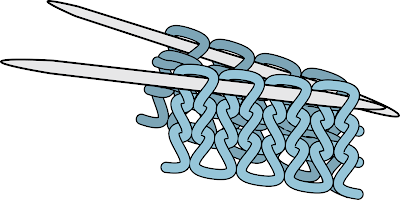
Slip 1 stitch purlwise from left/front needle to third needle.
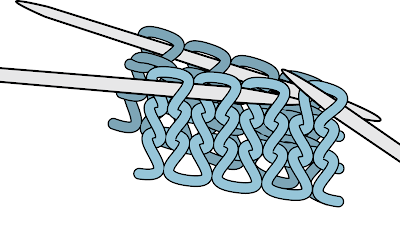
Slip 1 stitch purlwise from right/back needle to third needle.
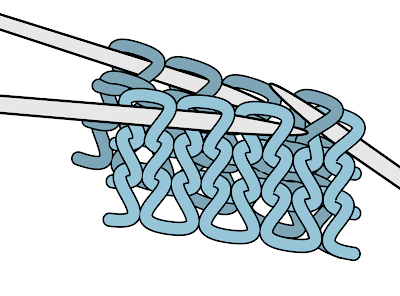
Repeat steps 2 and 3 until you have transferred all sts to your third needle.
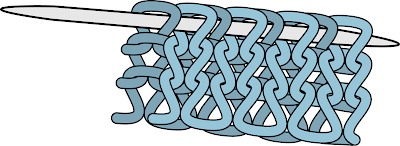
In the case of your sock, since you are working this section over an odd number of sts (this example shows an even number of sts), your result would begin and end with the sts from your left/front needle.
Leave these sts on their holder until you have finished the toes. At that point, you'll bind these sts together with applied I-cord.
Toes
Toes are worked in applied I-cord. Cords will be worked along columns of purl sts which run along top and sides of foot.
Please see Duck in knitty.com for detailed instructions on working the toes. This blog post focuses only on finishing the toes.
Work center toe first. Start and work over top of foot as described in Duck, then when you come to the tip of the webbing, work one more row without picking up any sts from the foot. Bind off and weave in ends. The idea here is, you want it to stick out just a little bit.
Work either of the side toes next, exactly as described in Duck. When you come to the stopping point of your first side toe, place the 3 live sts on holder and break yarn.
When you come to the stopping point on your next side toe, do not break the yarn -- this is now your working yarn.
Slip these 6 sts purlwise onto the same holder/dpn that has been holding your heel sts. You should now have a total of 25 sts on the holder.
Close Back of Heel
Heel will be closed by working applied I-cord, continuing from the side toes.
Next Row: K2, k2tog tbl. Sl sts purlwise back to left needle.
Repeat this row until all sts have been worked. 3 sts remain.
Cuff
Continuing from I-cord sts just worked, pick up and k 9 sts along upper edge of opening, k held sts of instep, pick up and k 9 sts along upper edge of opening. 34 sts.
Next Round: *K3, p2, [k2, p2] three times; repeat from * once.
Repeat this round 15 times more, or until cuff is desired length.
K 2 rounds. BO all sts using Jeny's Surprisingly Stretchy Bind Off.
FINISHING
Weave in ends. If desired, sew elastic thread through inside of cuff.
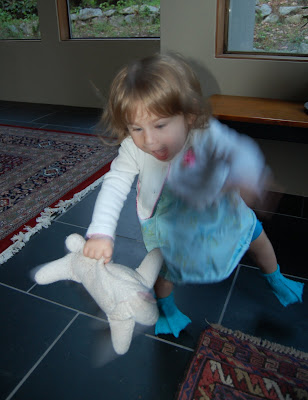

Omigosh! These are so cute! I think I have just found my project to work on while I wait for the rest of my yarn to arrive. My kiddo's feet are somewhat beyond the toddler stage so I'll be interested to see how/where to mod it to get it to fit her feet. Thank you SO much for sharing such interesting to knit patterns!
ReplyDeleteCOOOOL! I've been boobie feet in the wild, and I've been waiting since the duck feet pattern. Unfortunately I couldn't get them started for Easter, but now I'm excited to make them in lots of colors.
ReplyDeleteThanks for the inspiration!
These are beyond adorable.
ReplyDeletenow i just need a toddler....
ReplyDeleteGreat.
ReplyDeleteNow how about a grown up version? ;-)
That would be cool.
I have small feet, but not toddler small.
Love the baby version on knitty. I've already made two pairs as gifts. They're fun to knit!
ReplyDeleteThanks for the pattern, Jeny. I definitely have some toddler friends who would greatly appreicate these booby booties.
I have a niece who's 2 1/2 who I would love to make these for. I'm just concerned with sizing. Can you tell me about what size foot these should fit?
ReplyDeleteThanks!
I'm having a really hard time figuring out how to do the toes on Duck, I've never done applied I-cord so I'm sure it is really much easier than the knot I'm making of it. But any assistance or recommendations on sites/blogs that have nice detailed pictures would be great. I've tried using a thick worsted and size 8 needles so that it is all big enough to see easily until I get it figured out.
ReplyDeleteThanks again for any help--Katharine
katharineharris@rocketmail.com
Anyone got an adult version of this? I am trying to put together a booby costume for Halloween and yeah!
ReplyDeleteThank you so much for this pattern! I also love the baby version.
ReplyDeleteHi there, Very cute! I love blue-footed boobies. I came across this blog post while looking for duck sock knitting patterns. I've used one of your pictures with a link to your post on a blog post of my own (it relates a to a book about duck socks). I hope that's ok. You can see the blog post here: http://www.vrombaut.co.uk/duck-socks-collins-big-cat-phonics-book/ An
ReplyDeletebuy baby toys I think this is an informative post and it is very useful and knowledgeable. therefore, I would like to thank you for the efforts you have made in writing this article.
ReplyDeletei never know the use of adobe shadow until i saw this post. thank you for this! this is very helpful. buy baby toys
ReplyDeleteUm so I need a little help pls...
ReplyDeleteThis was posted a long time ago, so I'm not sure if anyone is paying attention.
ReplyDeleteI *do* have a question about the increase rows. The "duck feet" pattern says to increase using Turkish Cast-On and this pattern refers to the Duck Feet for working the toes.
I'm unsure what that means, exactly, as it's not a way I've ever increased before. It's also a bit confusing to me as one yarn "wrap" around the needles turns into two sts in Turkish Cast-On. Does "increase 2" mean wrap the yarn twice (generating 4 sts), or wrap the yarn once (generating 2 sts).
Thank you!
(I am a self-taught from-a-book knitter so I don't have any friends/family to lean on for their opinion on this increase method.)
Wonderul Online Digitizer
ReplyDeleteStand out this spooky season with a bold, edgy twist. The leather jacket Halloween costume adds instant attitude, making your outfit unforgettable, stylish, and perfect for haunted night adventures.
ReplyDelete